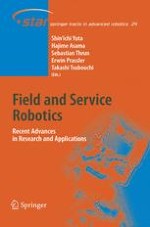2006 | Buch
Field and Service Robotics
Recent Advances in Reserch and Applications
herausgegeben von: Shin’ichi Yuta, Hajima Asama, Erwin Prassler, Takashi Tsubouchi, Sebastian Thrun
Verlag: Springer Berlin Heidelberg
Buchreihe : Springer Tracts in Advanced Robotics
